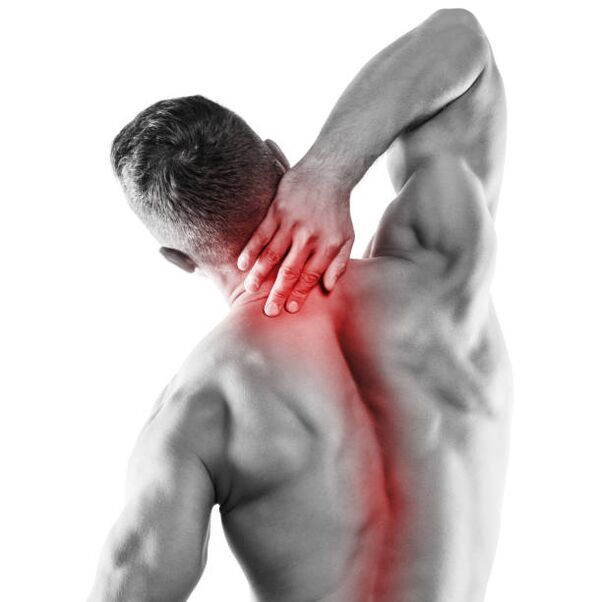Pain and stiffness in the neck occur with improper load, as well as some pathological conditions of the cervical spine. The painful sensation in the neck is almost always accompanied by its limited movement - when trying to turn or tilt the head, there is a sharp or increased pain. Sometimes it is so strong that one has to move the whole body instead of moving the neck. In this case, the pain can touch not only the neck, but also given to nearby areas - chest, arms, head, shoulders; accompanied by tinnitus, numbness of the hands and fingers, dizziness.

To prescribe competent treatment, you need to determine the cause of neck pain - this will be the task of the specialist you contact. Let’s think about what can cause pain in the cervical spine.
Causes of neck pain
There are 2 main causes of pain and limitation of neck movement: muscle spasms and cervical spine disease.
Neck stiffness
Stiffness is a condition in which muscles become tighter (unable to relax) and resist any attempt to move. Neck muscle spasm is not disease independent - it occurs either due to lack of physical activity, or joins some disease.
In connection with an inactive lifestyle - working at a computer, driving, doing less sports activities - the spine of the cervical spine can shift, aching pain, cramps caused by improper circulation of the cervical area appear.
Neck stiffness can also be a symptom:
- encephalitis, meningitis, cerebral hemorrhage. Other symptoms of the disease: headache, weakness, nausea, fever, dizziness, rash.
- parkinsonism. It is accompanied by tremors throughout the body, imbalance and automaticity of movement, and speech problems.
- neck injury. In such cases, the pain always precedes some serious mechanical impact on the neck (falls, blows).
Diseases of the cervical spine
Pain and limitation of movement in the cervical spine can occur due to pathology of the spinal space:
- Hernia. Severe pain radiates to the shoulders and arms, the palms can be twisted and numb, there is a "lumbago neck" - a sharp pain that prevents movement of the entire upper body.
- Cervical osteochondrosis. It is accompanied by headache, tinnitus, decreased visual acuity, "flies" blinking in front of the eyes, pain in the arms and shoulders.
- Cervical arthrosis. Pain occurs not only in the neck, but also in the shoulder area. He is most annoying in the morning and evening.
- Spondylosis. It is accompanied by occipital pain, numbness and tingling in the neck, hearing and vision problems, dizziness may occur.
- Cervical artery asymmetry. It is characterized by tinnitus, headache, darkening of the eyes, and increased blood pressure.
Which doctor should I go to for neck pain?
First of all, we recommend that you consult a general practitioner (therapist), who will determine the direction of further examination. To clarify the diagnosis and appointment of direct treatment, physicians with a narrower focus can be involved: rheumatologists, neurologists, traumatologists, orthopedists. Patients can also be referred to a chiropractor and massage therapist.
Diagnose the cause of neck pain
After oral questioning, the doctor examines the patient: examines the surface of the neck, examines the sensitivity of the arms and legs, the state of reflexes, finds out the presence of muscle spasms and hypertonicity.
From the hardware techniques used:
- radiography;
- MRI;
- CT scan;
- electromyography (EMG);
- ultrasound dopplerography (USDG) of the cervical canal.
Blood and urine tests can be taken to detect inflammatory processes in the body.
Treatment for cervical pain and cramps
Treatment for neck pain may include:
- Physiotherapy sessions (magnetotherapy, electrophoresis, ultrasound therapy, shock wave therapy).
- Prescription painkillers, sedatives, anti-inflammatory drugs, muscle relaxants.
- Holistic medical methods (acupuncture, massage, moxibustion, hirudotherapy, stone therapy, vacuum therapy).
- Physiotherapy, proper workplace organization, posture control.
- Surgical intervention. Radical surgical treatment methods are determined only if conservative methods are ineffective or with a more serious diagnosis, which initially involves surgery.
Treatment of neck pain in a medical center
High professionalism and impressive work experience of doctors allow you to choose the appropriate program for the treatment of neck diseases for each patient. The medical center is equipped with modern high -tech and reliable tools for laboratory and instrumental diagnostics, physiotherapy and treatment. And an experienced masseur and chiropractor will help not only relieve pain in the neck, but also generally improve the body.
If you are worried about pain and limited neck movement, make an appointment with us without expecting the condition to get worse.





































